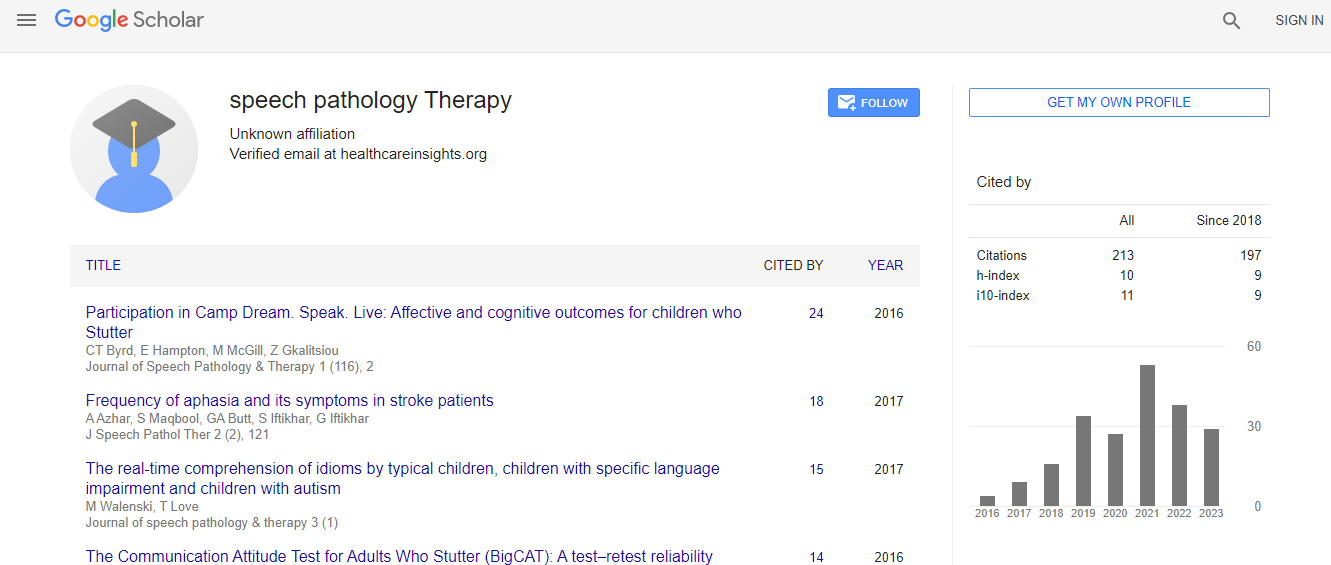Our Group organises 3000+ Global Conferenceseries Events every year across USA, Europe & Asia with support from 1000 more scientific Societies and Publishes 700+ Open Access Journals which contains over 50000 eminent personalities, reputed scientists as editorial board members.
Open Access Journals gaining more Readers and Citations
700 Journals and 15,000,000 Readers Each Journal is getting 25,000+ Readers
Google Scholar citation report
Citations : 273
Journal of Speech Pathology & Therapy received 273 citations as per Google Scholar report
Indexed In
- Google Scholar
- Open J Gate
- RefSeek
- Hamdard University
- EBSCO A-Z
- Euro Pub
- ICMJE
Useful Links
Recommended Journals
Related Subjects
Share This Page
Assessment and comparison of the different tracheotomy speaking valves
International Conference on Speech Language Pathology
Alan H Shikani
Sinai Hospital, USA MedStar Union Memorial Hospital, USA
ScientificTracks Abstracts: J Speech Pathol Ther
Abstract
Tracheotomy affects the patient at a very basic level: The ability to communicate. One-way speaking valves are designed to direct exhaled air over the vocal folds and restore speech. A variety of speaking valves has been described in the literature; the most commonly used being the Passy-Muir valve and the Shiley Phonate valves, which are flapper type valves. A newer type of unidirectional speaking valve, the Shikani Ball valve is based on a moving ball inside a chamber. Upon inspiration, the ball moves further back and air enters the trachea. On exhalation, the ball is flipped forward and seats into the valve opening, hence forcing the air to flow through the larynx and allowing speech. One advantage of the Shikani ball valve over the Passy-Muir or Shiley flapper valves speaking valves is that it offers substantially lower airflow resistance. The resistance inherent to the flapper valves may affect patient tolerance of the valves, thereby directly affecting both patient and valve selection. Hyposmia is a well-recognized phenomenon in patients who have had their nasal airflow diverted through a tracheotomy, believed to be due to elevated olfactory detection thresholds. The redirection in airflow that occurs with the use of a speaking valve has been theorized to be the cause of smell improvement. This study shows that the Shikani Ball valve significantly improves the loss of smell, as compared to the Shiley or the Passy Muir valves. Acoustic and perceptual evaluation was also generally more favorable with the Ball valve, most significantly with regards to speech naturalness. We did not note any significant difference in oxygen saturation levels. Eight out of 10 subjects subjectively preferred the ball valve, especially with regards to its low profile and ease of breathing and two preferred the Passy Muir valve.Biography
Alan H Shikani did his Residency and Fellowship training in Otolaryngology-Head & Neck Surgery at the Johns Hopkins Hospital in Baltimore and is currently the Chief of Otolaryngology-Head & Neck Surgery at the LifeBridge Sinai Hospital and MedStar Union Memorial Hospital. He is also an active Member of many distinguished societies including the Alpha Omega Honor Medical Society, the Triologic Society, the American College of Surgeons, the American Academy of Otolaryngology and the American Rhinologic Society. He has published numerous articles and book chapters in the field of otolaryngology-head & neck surgery. He is the Inventor of the Shikani speaking valve and Shikani HME and the Founder of the Airway Company.
Email: ashikani@gmail.com
 Spanish
Spanish  Chinese
Chinese  Russian
Russian  German
German  French
French  Japanese
Japanese  Portuguese
Portuguese  Hindi
Hindi 